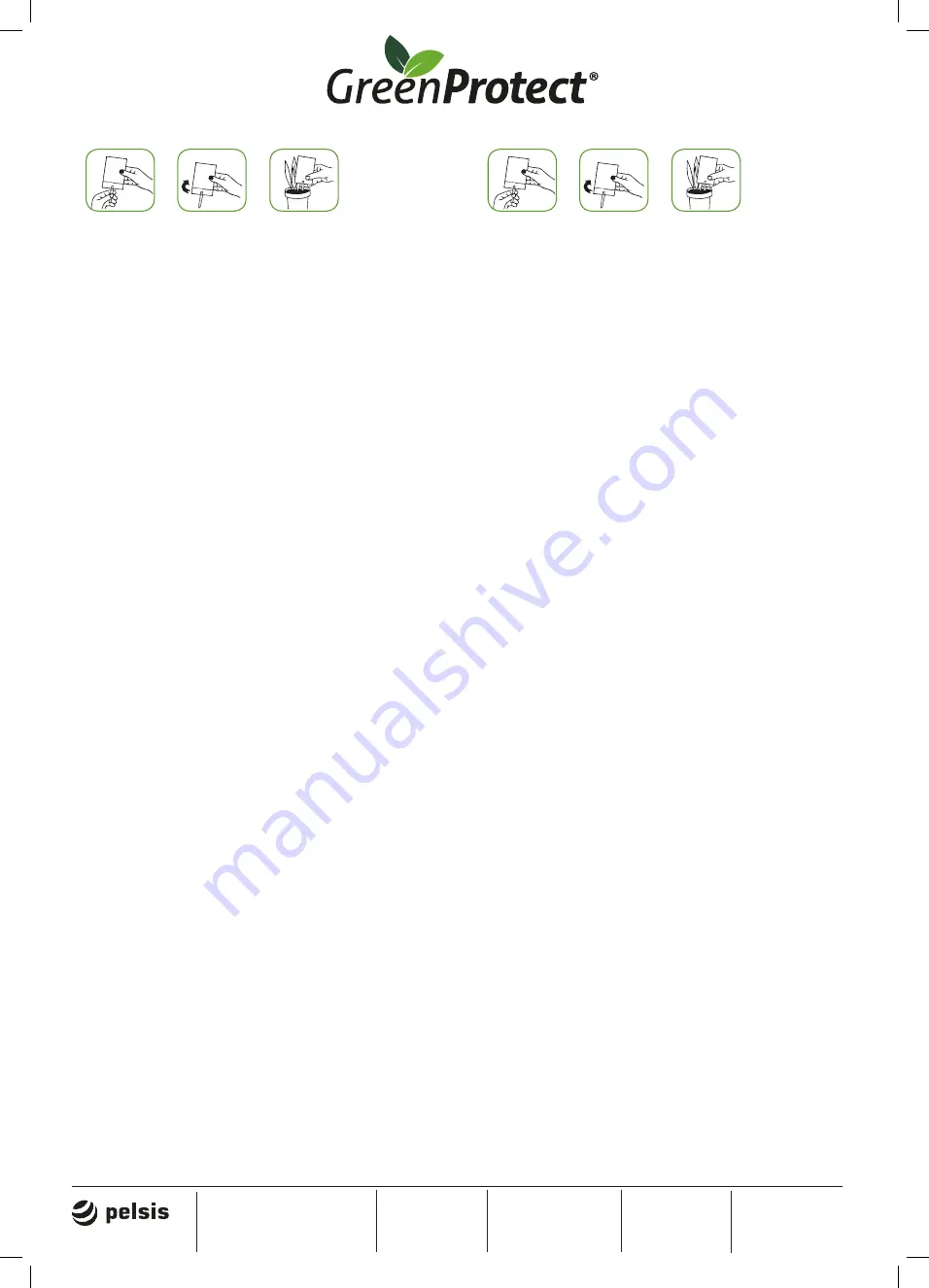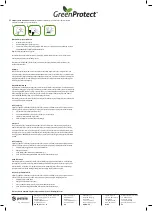
Sterling House, Grimbald Crag Close,
Knaresborough, North Yorkshire,
HG5 8PJ UK
+44 (0)800 988 5359
info@pelsis.com
EN, FR, DE, IT, PL, FI
Industrieweg 15
2880 Bornem
Belgium
+ 32 (0)3 886 22 11
info@pelsis.be
BE
www.pelsis.com
Glentevej 11
DK-6705 Esbjerg
Denmark
+ 45 75 14 48 00
tanaco@pelsis.com
DK, NO, SE
Gildeweg 37b
3771 NB Barneveld
Nederland
+31 342 420435
info@edialux.nl
NL, DE
Calle Juan de la Cierva
19, 03203 Elche
Alicante, Spain
+34 965 683 840
general@pelsis.com
ES
The Green Protect Pot Plant Insect Trap
is an effective trap, used to catch plant-feeding insects without
the use of insecticides.
Directions of use:
1.
Slide metal stake onto the bottom of the trap
2.
Carefully remove the cover paper from the glued trap
3.
Using the metal stake, position the trap within the soil of your plant pots.
Ensure it is not positioned where the trap
will make contact with the plant or pot.
Replace the trap when full or every 6 weeks.
Alternatively, the rectangular traps can be hung by threading a piece of string through the hole. It is suggested that you
thread the string prior to removing the cover paper for ease.
The trap covers an area of 10m², however, we recommend placing one trap in each pot plant for
complete coverage.
About the trap:
The Green Protect Pot Plant Insect Traps should be positioned early in the season before the insect population begins to
build up on your potted plant. The traps have been innovatively designed based on research proving that a number of
insects are attracted to specific colour wavelengths as they stimulate insect responses. The yellow tone has been found
to be especially attractive to Whitefly, Aphids, Fungus Gnats and Miner Flies. Due to the high-tech non-drying adhesive,
insects are caught quickly.
About Whitefly
The Whitefly has a white, wax-like, powder layer on top of its body and is around 2mm in size. They can be found on a
range of different plants and if you touch the plant, they will suddenly disperse. Both flies and the nymphs can be found
underneath the leaves as these small sucking insects take the nutrients from the plant and transmit disease, which results
in the plant drying out and losing its leaves. The whitefly and the nymphs secrete honeydew, making the leaves of the
plant sticky which potentially covering the plant in black mould. It is possible for female whitefly to lay 200-400 eggs
each season, which falls in late Spring. Whitefly are notorious for building up a resistance to synthetic chemical pesticides
therefore eco-friendly solutions are often the most effective solution.
How to get rid of Whitefly
When your Green Protect Pot Plant Insect Traps have detected the presence of plant-feeding insects, you may need to
implement measures to remove them. To remove whitefly from your home you can use the below simple, eco-friendly
methods:
1. Use a small hand vacuum to remove pests from under the leaves
2. Remove the extremely infected branches or leaves using garden cutters
3. Wash your plant with a soap / water solution
4.
Position a Green Protect Pot Plant Insect Trap in all potted plants
About Aphids
Aphids can have many different coloured appearances including yellow, green, black, grey and white or pink and brown.
They are around 2mm in size and can be found on plants inside and outside as they suck the sap from the leaves, causing
them to wither. Like Whitefly, Aphids secrete honeydew which makes the leaves of the plant sticky and potentially covered
in black mould. Aphids are often found on new, young plants where there are new leaves or flowers growing as they
contain the most nutrients. Due to disease transmission, Aphids can cause serious damage as they make the plant’s leaves
turn yellow and curl whilst growth is stunted.
How to get rid of Aphids
When your Green Protect Pot Plant Insect Traps have detected the presence of plant-feeding insects, you may need to
implement measures to remove them. To remove Aphids from your home you can use the below simple, eco-friendly
methods:
1. Wearing gloves, remove the Aphids by hand and dispatch between your fingers
2. Using a garden hose, spray the infected plants with water. Please avoid using a pressure that is high
enough to cause damage to the plant
3. Cut the plant back to reduce the chance of large colonies growing
4. Spray the plant with a soap / water solution
5.
Position a Green Protect Pot Plant Insect Trap in all potted plants
About Fungus Gnats
Fungus Gnats are small dark coloured flies, around 3mm in size that are often found in indoor plants, particularly where
humidity is high. The larvae of this pest causes damage to houseplants as they feed from the soil which damages the
plant’s roots resulting in the plant turning yellow and stunting growth. Although the adults live for only 1 week on
average, they lay up to 300 eggs which take 4-6 days for the larvae to emerge.
How to get rid of Fungus Gnats
When your Green Protect Pot Plant Insect Traps have detected the presence of plant-feeding insects, you may need to
implement measures to remove them. To remove Fungus Gnats from your home you can use
the below simple, eco-friendly
methods:
1. Keep soil dry by not over watering as the pest thrives in damp conditions
2. Add sand to help keep the soil dry and reduce larvae growth
3. Position a Green Protect Fruit Fly Trap near infected plants
4. Position a Green Protect Pot Plant Insect Trap in all potted plants
Contains: 10 traps. Active: 6 weeks. For more advice, please contact us.
Die Insektenfalle Green Protect Pot Plant
ist eine effektive Falle, die verwendet wird, um Pflanzenzüchtungen ohne
Insektizide zu fangen.
Gebrauchsanweisung:
1.
Metallschaufeln auf den Boden der Falle gleiten
2.
Das Deckpapier vorsichtig aus der geklebten Falle entfernen
3.
Mit dem Metalleinsatz positionieren Sie die Falle im Boden Ihrer Pflanzentöpfe.
Stellen Sie sicher, dass es nicht
dort positioniert ist, wo die Falle Kontakt mit der Pflanze oder dem Topf aufnehmen wird.
Ersetzen Sie die Falle, wenn sie voll oder alle 6 Wochen ist.
Alternativ können die rechteckigen Fallen aufgehängt werden, indem ein Stück durch das Loch gezogen wird. Es wird
empfohlen, dass Sie zum Abnehmen des Deckpapiers einfädeln.
Die Falle hat eine Fläche von 10 m², es wird jedoch empfohlen, in jeder Topfanlage.
Über die Falle:
Die Green Protect-Topfpflanzen-Insektenfallen sollten zu Beginn der Saison aufgestellt werden, bevor sich die
Insektenpopulation auf Ihrer Topfpflanze aufbaut. Die Fallen wurden auf der Grundlage von Forschungsergebnissen
innovativ gestaltet, die belegen, dass eine Anzahl von Insekten von bestimmten Farbwellenlängen angezogen wird,
da sie die Reaktion von Insekten stimulieren. Der Gelbton ist besonders für Whitefly, Blattläuse, Pilzmücken und
Bergmannsfliegen attraktiv. Durch den nicht-trocknenden High-Tech-Klebstoff werden Insekten schnell gefangen.
Über die weisse Fliege:
Die Whitefly hat eine weiße, wachsartige Pulverschicht auf ihrem Körper und ist etwa 2 mm groß. Sie können auf
verschiedenen Pflanzen gefunden werden und wenn Sie die Pflanze berühren, zerstreuen sie sich plötzlich. Sowohl
Fliegen als auch Nymphen sind unter den Blättern zu finden, da diese kleinen saugenden Insekten die Nährstoffe aus der
Pflanze entnehmen und Krankheiten übertragen, wodurch die Pflanze austrocknet und ihre Blätter verliert. Die Weiße
Fliege und die Nymphen scheiden den Honigtau aus, wodurch die Blätter der Pflanze klebrig werden, wodurch die Pflanze
möglicherweise mit schwarzem Schimmel bedeckt wird. Es ist möglich, dass die weibliche Weiße Fliege 200-400 Eier pro
Saison legt, was im späten Frühling fällt.
Whitefly ist bekannt dafür, Resistenzen gegen synthetische chemische Pestizide aufzubauen. Daher sind
umweltfreundliche Lösungen oft die effektivste Lösung.
Wie kann ich die weisse Fliege loswerden?
Wenn Ihre Insektenfallen der Green Protect-Topfpflanze das Vorhandensein pflanzenfressender Insekten erkannt haben,
müssen Sie möglicherweise Maßnahmen ergreifen, um diese zu entfernen. Um die Weiße Fliege von zu Hause aus zu
entfernen, können Sie die folgenden einfachen, umweltfreundlichen Methoden verwenden:
1.
Entfernen Sie mit einem Handstaubsauger Schädlinge unter den Blättern
2.
Entfernen Sie die stark befallenen Äste oder Blätter mit Gartenschneidern
3.
Waschen Sie Ihre Pflanze mit einer Seifenlösung
4.
Platzieren Sie in allen Topfpflanzen eine Green Protect Topfpflanzenfalle.
Über die Pilzmücken
Pilzmücken sind kleine, dunkelfarbige Fliegen, die in der Größe von ca. 3mm häufig in Zimmerpflanzen zu finden sind, vor
allem wenn die Luftfeuchtigkeit hoch ist. Die Larven dieser Schädlinge verursachen Schäden an den Zimmerpflanzen, da
sie sich vom Boden ernähren, was die Wurzeln der Pflanze schädigt, was dazu führt, dass die Pflanze gelb wird. Obwohl die
Erwachsenen im Schnitt nur eine Woche leben, legen sie bis zu 300 Eier, die 4-6 Tage brauchen, bis die Larven entstehen.
Wie man Pilzmücken loswird
Wenn Ihre Green Protect Topfpflanzen Insektenfallen das Vorhandensein von Pflanzenzinsekten festgestellt haben, müssen
Sie möglicherweise Maßnahmen ergreifen, um sie zu entfernen. Um Pilzmücken von zu Hause zu entfernen, können Sie
die folgenden einfachen, umweltfreundlichen Methoden anwenden:
1.
Boden trocken halten, indem man nicht übergießt, da der Schädling unter feuchten Bedingungen gedeiht
2.
Fügen Sie Sand hinzu, um den Boden trocken zu halten und das Larvenwachstum zu reduzieren
3.
Position einer grünen Schutzfrucht-Klebe-Falle in der Nähe infizierter Pflanzen
4.
Position einer grünen Schutztopfpflanzenintenfalle in allen Topfpflanzen
Über Blattläuse:
Blattläuse können viele verschiedene farbige Erscheinungen haben, einschließlich gelb, grün, schwarz, grau und weiß oder
rosa und braun. Sie sind etwa 2 mm groß und können an Pflanzen drinnen und draußen gefunden werden, wenn sie den
Saft aus den Blättern saugen und verdorren. Wie die weisse Fliege scheiden Blattläuse Honigtau aus, wodurch die Blätter
der Pflanze klebrig werden und möglicherweise mit schwarzem Schimmel bedeckt sind. Blattläuse werden häufig bei
neuen, jungen Pflanzen gefunden, bei denen neue Blätter oder Blüten wachsen, da sie die meisten Nährstoffe enthalten.
Aufgrund der Übertragung von Krankheiten können Blattläuse ernsthafte Schäden verursachen, da die Blätter der Pflanze
gelb werden und sich kräuseln, während das Wachstum behindert wird.
Wie Sie Blattläuse loswerden
Wenn Ihre Insektenfallen der Green Protect-Topfpflanze das Vorhandensein pflanzenfressender Insekten erkannt haben,
müssen Sie möglicherweise Maßnahmen ergreifen, um diese zu entfernen. Um die Blattläuse von zu Hause zu entfernen,
können Sie die folgenden einfachen, umweltfreundlichen Methoden verwenden:
1.
Mit Handschuhen die Blattläuse von Hand entfernen und zwischen die Finger schieben
2.
Besprühen Sie die infizierten Pflanzen mit einem Gartenschlauch mit Wasser. Vermeiden Sie es, einen Druck zu
verwenden, der hoch genug ist, um die Anlage zu beschädigen
3.
Schneiden Sie die Pflanze zurück, um die Wahrscheinlichkeit zu verringern, dass große Kolonien wachsen
4.
Besprühen Sie die Pflanze mit einer Seifenlösung
5.
Platzieren Sie in allen Topfpflanzen eine Green Protect Pot Plant-Insektenfalle
Enthält: 10 Fallen. Aktiv: 6 Wochen. Für weitere Beratung kontaktieren Sie uns bitte.
EN-
DE-
1.
2.
3.
1.
2.
3.




















